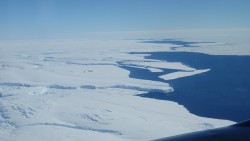Unstable Glacier Caused Past Sea Level Rise
October 11, 2016

Research published in the journal Nature on May 19, 2016, has revealed that vast regions of the Totten Glacier in East Antarctica are fundamentally unstable and have contributed significantly to rising sea levels several times in the past.
Totten Glacier is the most rapidly thinning glacier in East Antarctica. This study raises concerns that a repeat transition between stable and unstable states could be underway as the climate warms. The University of Texas Institute for Geophysics (UTIG) led the research and data collection for the study. Alan Aitken of the University of Western Australia’s School of Earth and Environment is the lead author.
Totten Glacier is East Antarctica’s largest outlet of ice and a key region for understanding the large-scale and long-term vulnerabilities of the Antarctic Ice Sheet. Whereas other studies have indicated that this region of the ice sheet may have retreated in the past, this study reveals direct linkages between the modern Totten Glacier and the eroded landscape currently buried in ice hundreds of kilometers inland.
“We now know how the ice sheet evolves over the landscape in East Antarctica and where it is susceptible to rapid retreat, which gives us insight into what is likely to happen in the years ahead,” said Donald D. Blankenship, lead principal investigator of ICECAP (International Collaboration for Exploration of the Cryosphere through Aerogeophysical Profiling) and a senior research scientist at UTIG.
The UTIG-led ICECAP project collected the data during five Antarctic field campaigns using an aircraft equipped with instruments to assess the ice and measure the shape of the landscape and rocks beneath it. ICECAP is a longterm international collaboration with the United States, Australia, the United Kingdom and France.
Back to the Newsletter